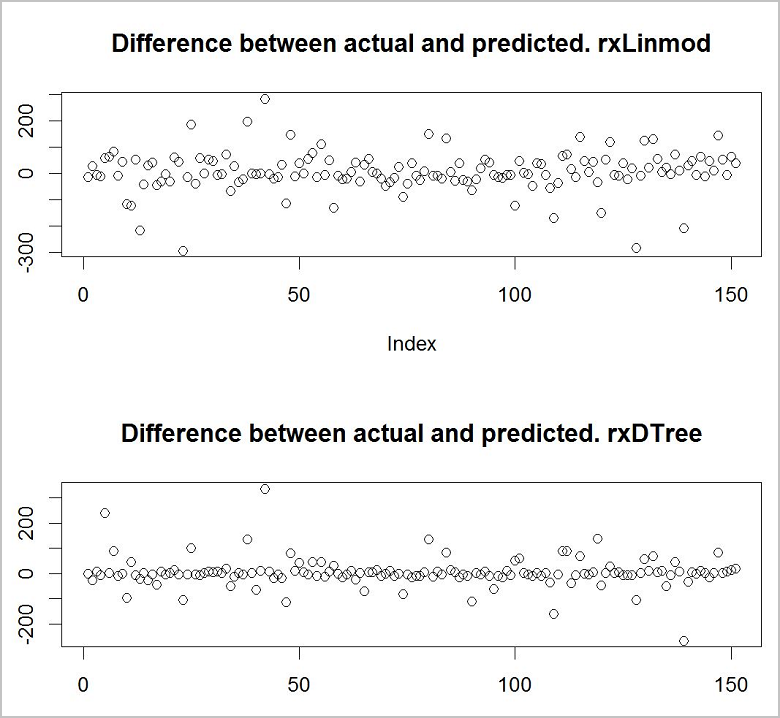チュートリアル:SQL 機械学習を使用して R で予測モデルを作成する
適用対象: SQL Server 2016 (13.x) 以降
Azure SQL Managed Instance
この 4 部構成のチュートリアル シリーズのパート 3 では、R で予測モデルをトレーニングします。このシリーズの次のパートでは、Machine Learning Services またはビッグ データ クラスターを使用して、このモデルを SQL Server データベースにデプロイします。
この 4 部構成のチュートリアル シリーズのパート 3 では、R で予測モデルをトレーニングします。このシリーズの次のパートでは、Machine Learning Services を使用して、このモデルを SQL Server データベースにデプロイします。
この 4 部構成のチュートリアル シリーズのパート 3 では、R で予測モデルをトレーニングします。このシリーズの次のパートでは、SQL Server R Services を使用して、このモデルをデータベースにデプロイします。
この 4 部構成のチュートリアル シリーズのパート 3 では、R で予測モデルをトレーニングします。このシリーズの次のパートでは、Machine Learning Services を使用して、このモデルを Azure SQL Managed Instance データベースにデプロイします。
この記事では、次の方法について学習します。
- 2 つの機械学習モデルをトレーニングする
- 両方のモデルで予測を行う
- 結果を比較して最も正確なモデルを選択する
第 1 部では、サンプル データベースを復元する方法を学習しました。
パート 2 では、データベースから Python データ フレームにデータを読み込み、R でデータを準備する方法を学習しました。
パート 4 では、モデルをデータベースに格納した後、パート 2 と 3 で開発した Python スクリプトからストアド プロシージャを作成する方法について学習します。 ストアド プロシージャは、新しいデータに基づいて予測を行うためにサーバーで実行されます。
前提条件
このチュートリアル シリーズのパート 3 は、パート 1の前提条件を満たし、パート 2の手順を完了していることを前提としています。
2 つのモデルをトレーニングする
スキー レンタル データに最適なモデルを見つけるために、2 つの異なるモデル (線形回帰とデシジョン ツリー) を作成し、どちらの予測がより正確であるかを調べます。 このシリーズのパート 1 で作成したデータ フレーム rentaldata を使用します。
#First, split the dataset into two different sets:
# one for training the model and the other for validating it
train_data = rentaldata[rentaldata$Year < 2015,];
test_data = rentaldata[rentaldata$Year == 2015,];
#Use the RentalCount column to check the quality of the prediction against actual values
actual_counts <- test_data$RentalCount;
#Model 1: Use lm to create a linear regression model, trained with the training data set
model_lm <- lm(RentalCount ~ Month + Day + WeekDay + Snow + Holiday, data = train_data);
#Model 2: Use rpart to create a decision tree model, trained with the training data set
library(rpart);
model_rpart <- rpart(RentalCount ~ Month + Day + WeekDay + Snow + Holiday, data = train_data);
両方のモデルで予測を行う
予測関数を使用し、トレーニング済みの各モデルを使ってレンタル数を予測します。
#Use both models to make predictions using the test data set.
predict_lm <- predict(model_lm, test_data)
predict_lm <- data.frame(RentalCount_Pred = predict_lm, RentalCount = test_data$RentalCount,
Year = test_data$Year, Month = test_data$Month,
Day = test_data$Day, Weekday = test_data$WeekDay,
Snow = test_data$Snow, Holiday = test_data$Holiday)
predict_rpart <- predict(model_rpart, test_data)
predict_rpart <- data.frame(RentalCount_Pred = predict_rpart, RentalCount = test_data$RentalCount,
Year = test_data$Year, Month = test_data$Month,
Day = test_data$Day, Weekday = test_data$WeekDay,
Snow = test_data$Snow, Holiday = test_data$Holiday)
#To verify it worked, look at the top rows of the two prediction data sets.
head(predict_lm);
head(predict_rpart);
RentalCount_Pred RentalCount Month Day WeekDay Snow Holiday
1 27.45858 42 2 11 4 0 0
2 387.29344 360 3 29 1 0 0
3 16.37349 20 4 22 4 0 0
4 31.07058 42 3 6 6 0 0
5 463.97263 405 2 28 7 1 0
6 102.21695 38 1 12 2 1 0
RentalCount_Pred RentalCount Month Day WeekDay Snow Holiday
1 40.0000 42 2 11 4 0 0
2 332.5714 360 3 29 1 0 0
3 27.7500 20 4 22 4 0 0
4 34.2500 42 3 6 6 0 0
5 645.7059 405 2 28 7 1 0
6 40.0000 38 1 12 2 1 0
結果を比較する
次に、どちらのモデルで最善の予測が得られるかを調べます。 これを行うための迅速で簡単な方法は、基本的なプロット関数を使用して、トレーニング データの実際の値と予測値の差を表示することです。
#Use the plotting functionality in R to visualize the results from the predictions
par(mfrow = c(1, 1));
plot(predict_lm$RentalCount_Pred - predict_lm$RentalCount, main = "Difference between actual and predicted. lm")
plot(predict_rpart$RentalCount_Pred - predict_rpart$RentalCount, main = "Difference between actual and predicted. rpart")

2 つのモデルのうち、デシジョン ツリー モデルの方がより正確であるように見えます。
リソースをクリーンアップする
このチュートリアルを続行しない場合は、TutorialDB データベースを削除してください。
次のステップ
このチュートリアル シリーズのパート 3 で学習した内容は次のとおりです。
- 2 つの機械学習モデルをトレーニングする
- 両方のモデルで予測を行う
- 結果を比較して最も正確なモデルを選択する
作成した機械学習モデルをデプロイするには、このチュートリアル シリーズのパート 4 の手順に従います。